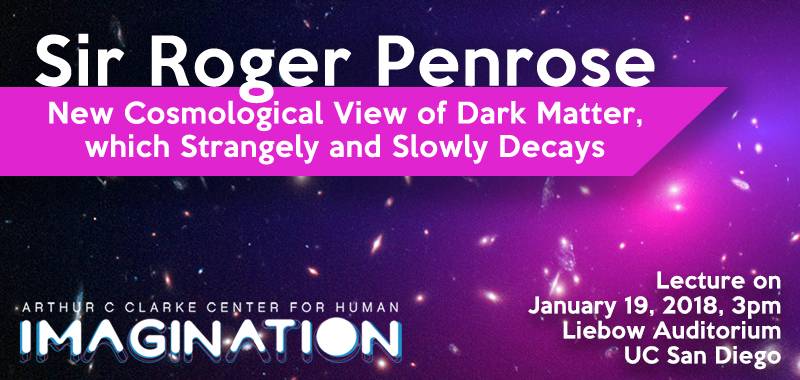Jan 19, 2018–Jan 19, 2018 from 3:00pm–4:00pm
Sir Roger Penrose: New Cosmological View of Dark Matter

“New Cosmological View of Dark Matter, which Strangely and Slowly Decays” Lecture by Sir Roger Penrose, Oxford University January 19, 2018, 3pm Liebow Auditorium UC San Diego Free and open to the public (seating first-come, first-served) Sir Roger Penrose will give a talk on his latest research and provide an insight into the thinking of a modern day theoretical physicist. Is the Universe destined to collapse, ending in a big crunch or to expand indefinitely until it homogenizes in a heat death? Roger will explain a third alternative, the cosmological conformal cyclic cosmology (CCC) scheme—where the Universe evolves through eons, each ending in the decay of mass and beginning again with new Big Bang. The equations governing the crossover from each aeon to the next demand the creation of a dominant new scalar material, postulated to be dark matter. In order that this material does not build up from aeon to aeon, it is taken to decay away completely over the history of each aeon. The dark matter particles (erebons) may be expected to behave almost as classical particles, though with bosonic properties; they would probably be of about a Planck mass, and interacting only gravitationally. Their decay would produce gravitational signals, and be responsible for the approximately scale invariant temperature fluctuations in the CMB of the succeeding aeon. In our own aeon, erebon decay might well show up in signals discernable by gravitational wave detectors. The talk will blend Roger’s accessible style with an unapologetic detailed look at the physical principles. It should be of interest to practicing physicists and lay people who enjoy taking a more detailed look at physics. Sir Roger Penrose, Emeritus Professor at the Mathematical Institute of the University of Oxford, winner of the Copley Medal and the Wolf Prize in Physics, which he shared with Stephen Hawking, has made profound contributions encompassing geometry, black hole singularities, the unification of quantum mechanics and general relativity, the structure of space-time, nature of consciousness and the origin of our Universe. His geometric creations, developed with his father Lionel, inspired the works of MC Escher, and the Penrose Steps have been featured in several movies. His tilings adorn many public buildings, including the Oxford Mathematics Institute and will soon decorate the San Francisco Transit Terminal. Their fivefold symmetry, which was initially thought impossible or a mathematical curiosity, has now been found in nature. In 1989 Penrose wrote The Emperor’s New Mind which challenged the premise that consciousness is computation and proposed new physics to understand it. Presented by the Arthur C. Clarke Center for Human Imagination at UC San Diego and the Penrose Institute. Dr. Penrose was featured as a guest on Into the Impossible, the Clarke Center’s podcast, on episode 10: Pictures, Pastries, and the Matter of the Universe. Directions: The Liebow Auditorium is located in the Basic Science Building at the School of Medicine on the UCSD campus. As there is no physical address, please see directions below. From Interstate 5:
- Exit La Jolla Village drive.
- If northbound, turn LEFT at off-ramp. If southbound, turn RIGHT.
- At the first stop light turn right onto Villa La Jolla drive and go up the hill (staying in the left lane).
- You will pass the VA Medical Center on the right.
- At the second stop light, drive straight ahead into the Gilman parking structure.
- Purchase a parking permit from machine. ($1.00/hour and takes credit cards).
- Start walking out of the parking structure to the right towards Meyers drive.
- Cross Gilman drive and head towards the Basic Science Building.
- Liebow Auditorium is in the Basic Science Building on the 2nd floor.
Date and Time
Jan 19, 2018–Jan 19, 2018
from 3:00pm–4:00pm
Location
Liebow Auditorium, Basic Science Building
Event Registration
Registration is not required for this event.
Event Fee
Free
Contact
Patrick Coleman • pcoleman@ucsd.edu • 858-534-6875
Audience
Faculty, Staff, Students, The General Public
Event Host
Arthur C. Clarke Center for Human Imagination